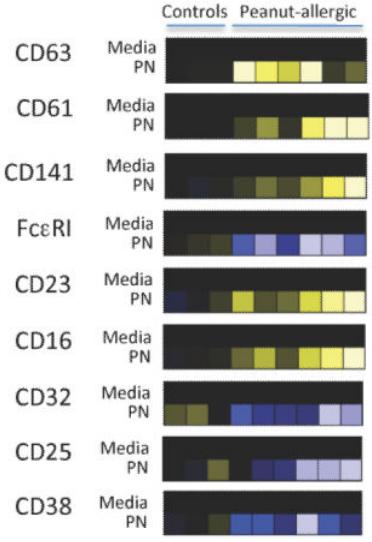Immunomics Services
Immunomics Services for Basophils
As the rarest granulocytes, basophils have diverse and critical roles in disease propagation, including clearance of pathogens and initiation of inflammatory processes in cancer, autoimmunity, and allergy. CD Genomics offers immunomics services for basophils to help clients understand the phenotype, morphology, and function of basophils.

Introduction to Basophils
Basophils are a type of leukocyte that is the least common granulocyte type, consisting of approximately 0.5% to 1% of circulating leukocytes. Interestingly, they are the largest granulocyte type. Basophils contain large cytoplasmic granules that, when stained, obscure the nucleus under the microscope.
Function of Basophils
Basophils have been identified as effector cells for type 2 inflammatory responses, including their production of IL-4, IL-5, IL-25, and TSLP. Basophils are responsible for inflammatory responses and the development of acute and chronic allergic diseases such as anaphylaxis, asthma, atopic dermatitis, and hay fever. In addition, basophils are the only histamine-containing white blood cells circulating in the body. During an allergic reaction, histamine causes many typical allergy symptoms such as a runny nose or sneezing.
Research on Allergic Diseases by Basophils Immunomics
Studies on basophils have focused on allergies. Despite their low abundance, basophils play an important role in the pathobiology of disease and elicit powerful functional responses such as the rapid release of granulins and histamine. As the number of patients suffering from allergies or related disorders continues to increase, research on the characterization of allergens and on diagnostic and therapeutic approaches to allergies has become more necessary than ever.
- Efficacy Prediction of Treatment of Allergy
To investigate the mechanism by which omalizumab is effective in controlling the symptoms of chronic idiopathic urticaria (CIU), 322 proteins of basophils are examined. Thirty proteins are found only in omalizumab responders, 196 only in non-responders, and 96 in both groups. Intermediate filament proteins and cytoskeletal or adhesion proteins, each accounting for 8 of the 30 proteins, are found only in responders.
- Research on Basophils in Allergic Patients
Traditional flow cytometry has been used to immunophenotype basophils, and there have been some studies using mass cytometry to interrogate basophilic cell areas. It is found that along with the upregulation of CD63, FcεRI, CD23, CD16, and CD32 expression, basophils are apparently the most sensitive cells to peanut stimulation in the blood of peanut-allergic patients.
 Fig.1 Expression of each marker by
basophils stimulated with peanut. (Tordesillas, L., et al., 2016)
Fig.1 Expression of each marker by
basophils stimulated with peanut. (Tordesillas, L., et al., 2016)
Our Services
The heterogeneity of most human granulocytes, such as neutrophils and eosinophils, has been extensively studied, which illuminates their many functions in human health and disease. However, studies focusing on basophils are often limited due to their rarity (<1%) in human blood. CD Genomics offers immunomics studies targeting basophils to help clients elucidate their functions in multiple diseases such as inflammation, autoimmunity, and cancer.
Multiple Research Methods
For a comprehensive study of basophils, we offer a variety of histological studies for them, including but not limited to the following.
Most notably, we offer CyTOF services to help our clients characterize basophils to study and evaluate their heterogeneity and function.
Data Analysis Services
The data analysis team at CD Genomics consists of professional bioinformatics experts who can help clients interpret high-dimensional experimental data.
Why Choose Us
Although basophils are rare in the body and their study is hampered, CD Genomics is able to help clients solve the challenges of studying basophil projects based on our extensive experience in immunomics research. Please contact us for more information.
Reference
- Tordesillas, L., Rahman, A. H., Hartmann, B. M., Sampson, H. A., & Berin, M. C. (2016). Mass cytometry profiling the response of basophils and the complete peripheral blood compartment to peanut. Journal of Allergy and Clinical Immunology, 138(6), 1741-1744.
